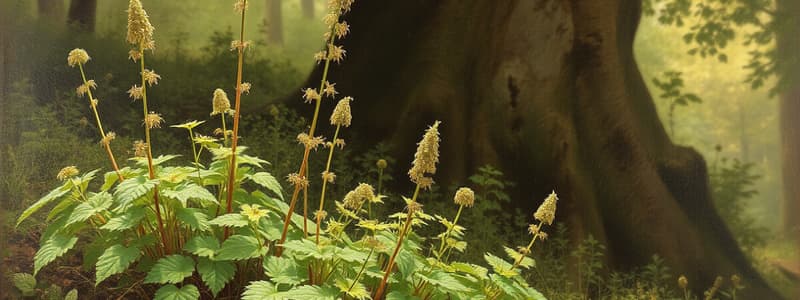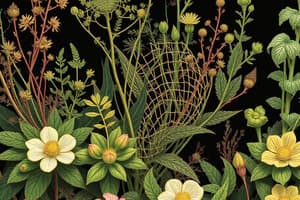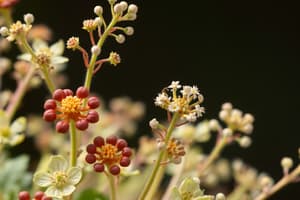Podcast
Questions and Answers
What type of plants are bryophytes classified as?
What type of plants are bryophytes classified as?
- Cryptogams
- Angiosperms
- Vascular plants
- Nonvascular plants (correct)
What structures do bryophytes use instead of roots?
What structures do bryophytes use instead of roots?
- Fibrous roots
- Rhizoids (correct)
- Stems
- True leaves
Which of the following factors limits the efficiency of bryophytes in water absorption?
Which of the following factors limits the efficiency of bryophytes in water absorption?
- Lack of roots
- The absence of true leaves (correct)
- The presence of vascular tissue
- Their size
How do bryophytes reproduce?
How do bryophytes reproduce?
Which bryophyte type is typically considered to have evolved last?
Which bryophyte type is typically considered to have evolved last?
What is the primary characteristic of nonvascular plants that distinguishes them from vascular plants?
What is the primary characteristic of nonvascular plants that distinguishes them from vascular plants?
What is the primary habitat where mosses thrive?
What is the primary habitat where mosses thrive?
What generation is produced after fertilization in bryophytes?
What generation is produced after fertilization in bryophytes?
Which type of bryophyte is most similar to vascular plants?
Which type of bryophyte is most similar to vascular plants?
What role do rhizoids play in the life of bryophytes?
What role do rhizoids play in the life of bryophytes?
What are the three types of modern nonvascular plants?
What are the three types of modern nonvascular plants?
Which type of vascular tissue is responsible for transporting water and dissolved minerals?
Which type of vascular tissue is responsible for transporting water and dissolved minerals?
What characterizes the sporophytes of hornworts?
What characterizes the sporophytes of hornworts?
Which of the following statements accurately describes nonvascular plants?
Which of the following statements accurately describes nonvascular plants?
What adaptation did early vascular plants have that allowed them to grow taller?
What adaptation did early vascular plants have that allowed them to grow taller?
What do clubmosses and ferns have in common?
What do clubmosses and ferns have in common?
Why were early vascular plants able to take advantage of sunlight high above the ground?
Why were early vascular plants able to take advantage of sunlight high above the ground?
What distinguishes the cells of phloem from those of xylem?
What distinguishes the cells of phloem from those of xylem?
How do mosses primarily retain moisture?
How do mosses primarily retain moisture?
What feature is not present in nonvascular plants?
What feature is not present in nonvascular plants?
All plants require true roots to survive.
All plants require true roots to survive.
Bryophytes are known for their ability to thrive in dry environments.
Bryophytes are known for their ability to thrive in dry environments.
Mosses are small nonvascular plants that grow in colonies and are typically less than 10 centimeters tall.
Mosses are small nonvascular plants that grow in colonies and are typically less than 10 centimeters tall.
The first plants to evolve were vascular plants.
The first plants to evolve were vascular plants.
Vascular plants, known as tracheophytes, evolved from moss-like bryophyte ancestors approximately 420 million years ago.
Vascular plants, known as tracheophytes, evolved from moss-like bryophyte ancestors approximately 420 million years ago.
Mosses are completely devoid of any vascular tissue.
Mosses are completely devoid of any vascular tissue.
Xylem tissue in vascular plants is responsible for transporting food and sugars to various parts of the plant.
Xylem tissue in vascular plants is responsible for transporting food and sugars to various parts of the plant.
Sperm from a male gametophyte in bryophytes requires water to reach the female gametophyte.
Sperm from a male gametophyte in bryophytes requires water to reach the female gametophyte.
Clubmosses and ferns are both types of seedless vascular plants that reproduce using spores.
Clubmosses and ferns are both types of seedless vascular plants that reproduce using spores.
Early vascular plants evolved true roots that were primarily responsible for absorbing water and minerals from the air.
Early vascular plants evolved true roots that were primarily responsible for absorbing water and minerals from the air.
Flashcards are hidden until you start studying
Study Notes
Nonvascular Plants
- Nonvascular plants, also known as bryophytes, include liverworts, hornworts, and mosses, with over 17,000 species existing.
- Lacking vascular tissues, true leaves, seeds, and flowers, bryophytes are typically small and anchored by hair-like structures called rhizoids.
- Rhizoids, which are often just one cell thick, function to absorb moisture and nutrients but are less efficient than roots found in vascular plants.
- Reproduction in bryophytes requires moisture for sperm to swim to eggs, resulting in sporophytes that produce haploid spores needing moisture for dispersal.
- Bryophytes were the first plants to evolve, with liverworts being the oldest, followed by hornworts, and mosses being the most recent evolution among them.
- Mosses, having structures similar to leaves, grow in dense clumps and help retain moisture, contrasting with liverworts and hornworts which are smaller and have more delicate structures.
Characteristics of Nonvascular Plants
- Nonvascular plants require moist habitats and reproduce through spores, which is a significant contrast to seed-bearing plants.
- Liverworts have lobed or ribbon-like photosynthetic tissues and grow in colonies, while hornworts feature horn-like sporophytes.
- Mosses are the largest nonvascular plants, characterized by a central stem-like structure and multicellular rhizoids.
Vascular Plants
- Vascular plants, or tracheophytes, evolved approximately 420 million years ago from moss-like ancestors, leading to taller growth and more efficient nutrient transport due to their vascular systems.
- Vascular tissues include xylem, which transports water and minerals from roots, and phloem, which transports sugars and nutrients, both structured to maximize transport efficiency.
- Xylem comprises dead cells with reinforced, waterproof walls allowing for efficient upward water transport, while phloem consists of living cells with perforated walls for nutrient distribution.
Evolution of Vascular Plants
- The evolution of vascular plants marked significant adaptations, such as the development of true roots for effective nutrient absorption and anchorage.
- Unlike rhizoids, roots allow for larger growth and stability, while stems made of vascular tissue enable plants to grow taller for light access.
- Initial leaves were adapted to minimize water loss, evolving over time into larger forms for increased light capture.
Diversity of Seedless Vascular Plants
- Seedless vascular plants include clubmosses and ferns, with over 1,200 species of clubmoss and more than 20,000 species of ferns.
- Clubmosses resemble mosses but possess true roots, stems, and leaves, while ferns exhibit larger leaves and can reach significant heights.
- Both types reproduce via spores and demonstrate a diverse range of forms and habitats, contributing to lush terrestrial ecosystems.
Summary
- Nonvascular plants, or bryophytes, do not possess roots, stems, or leaves and primarily thrive in moist environments through spore reproduction.
- Vascular plants, known as tracheophytes, have specialized transport tissues (xylem and phloem) allowing for taller growth, enhanced nutrient uptake, and more complex structures.
Nonvascular Plants
- Nonvascular plants, also known as bryophytes, include liverworts, hornworts, and mosses, with over 17,000 species existing.
- Lacking vascular tissues, true leaves, seeds, and flowers, bryophytes are typically small and anchored by hair-like structures called rhizoids.
- Rhizoids, which are often just one cell thick, function to absorb moisture and nutrients but are less efficient than roots found in vascular plants.
- Reproduction in bryophytes requires moisture for sperm to swim to eggs, resulting in sporophytes that produce haploid spores needing moisture for dispersal.
- Bryophytes were the first plants to evolve, with liverworts being the oldest, followed by hornworts, and mosses being the most recent evolution among them.
- Mosses, having structures similar to leaves, grow in dense clumps and help retain moisture, contrasting with liverworts and hornworts which are smaller and have more delicate structures.
Characteristics of Nonvascular Plants
- Nonvascular plants require moist habitats and reproduce through spores, which is a significant contrast to seed-bearing plants.
- Liverworts have lobed or ribbon-like photosynthetic tissues and grow in colonies, while hornworts feature horn-like sporophytes.
- Mosses are the largest nonvascular plants, characterized by a central stem-like structure and multicellular rhizoids.
Vascular Plants
- Vascular plants, or tracheophytes, evolved approximately 420 million years ago from moss-like ancestors, leading to taller growth and more efficient nutrient transport due to their vascular systems.
- Vascular tissues include xylem, which transports water and minerals from roots, and phloem, which transports sugars and nutrients, both structured to maximize transport efficiency.
- Xylem comprises dead cells with reinforced, waterproof walls allowing for efficient upward water transport, while phloem consists of living cells with perforated walls for nutrient distribution.
Evolution of Vascular Plants
- The evolution of vascular plants marked significant adaptations, such as the development of true roots for effective nutrient absorption and anchorage.
- Unlike rhizoids, roots allow for larger growth and stability, while stems made of vascular tissue enable plants to grow taller for light access.
- Initial leaves were adapted to minimize water loss, evolving over time into larger forms for increased light capture.
Diversity of Seedless Vascular Plants
- Seedless vascular plants include clubmosses and ferns, with over 1,200 species of clubmoss and more than 20,000 species of ferns.
- Clubmosses resemble mosses but possess true roots, stems, and leaves, while ferns exhibit larger leaves and can reach significant heights.
- Both types reproduce via spores and demonstrate a diverse range of forms and habitats, contributing to lush terrestrial ecosystems.
Summary
- Nonvascular plants, or bryophytes, do not possess roots, stems, or leaves and primarily thrive in moist environments through spore reproduction.
- Vascular plants, known as tracheophytes, have specialized transport tissues (xylem and phloem) allowing for taller growth, enhanced nutrient uptake, and more complex structures.
Studying That Suits You
Use AI to generate personalized quizzes and flashcards to suit your learning preferences.




